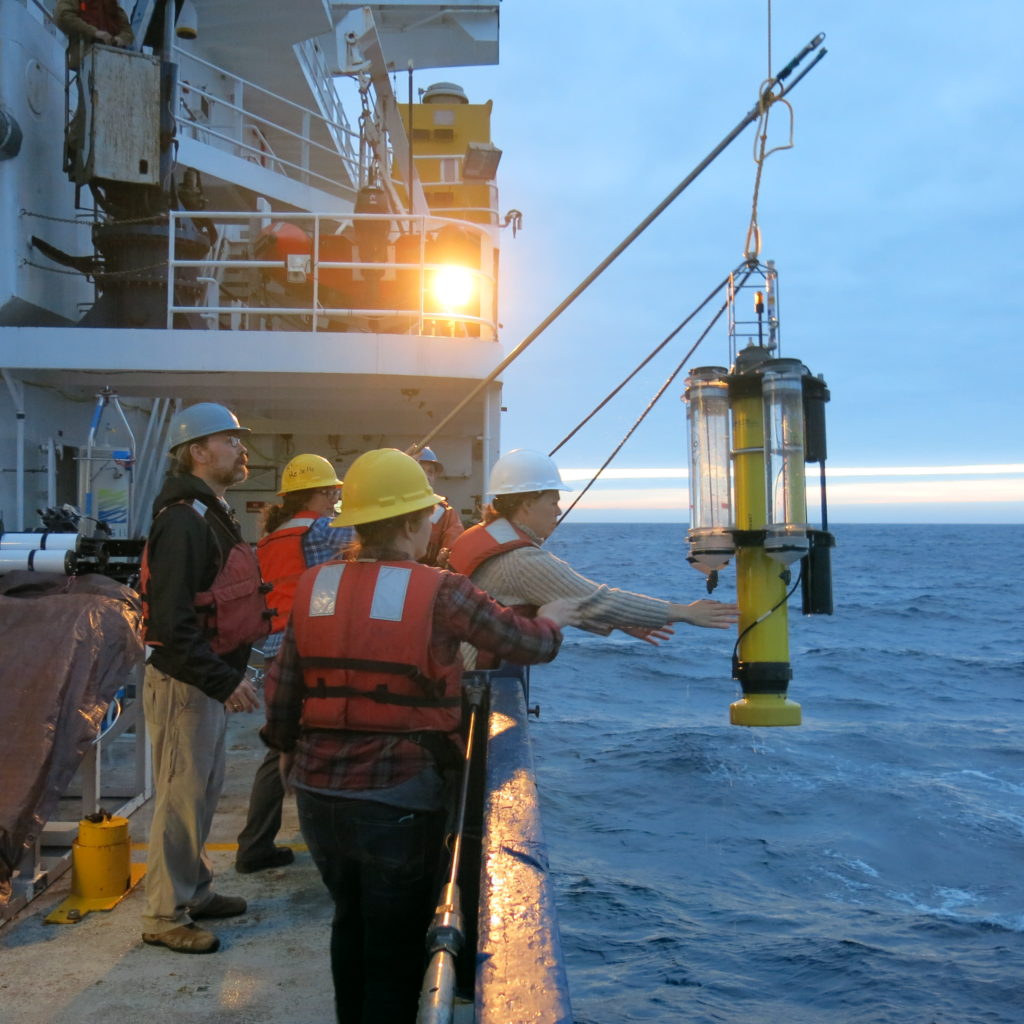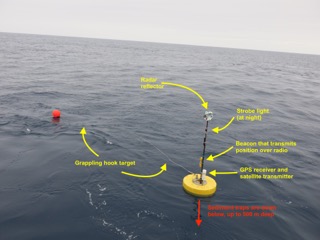
by Meg Estapa / NORTHEAST PACIFIC OCEAN /
Meg Estapa is an assistant professor at Skidmore College and leads the EXPORTS sediment trap team. Her current work focuses on the optical properties of sinking particles and how these can serve as proxy measurements to help us better characterize the spatial and temporal scales of the biological pump. She is currently working aboard the R/V Roger Revelle.
One of the unusual things about the EXPORTS field campaign is the number of independently drifting instruments that we are using. These instruments include profiling floats, gliders, self-ballasted and moored sediment traps, and wave-powered profilers. Untethered from the ships, they multiply the observations we can make directly from the R/Vs Revelle and Ride. My team on the Revelle is responsible for all of the sediment traps and the wave-powered profiler (also known as the WireWalker). Right now we have seven different sampling devices to keep track of that are drifting out there in the ocean! Needless to say, in addition to our science, much of our mental energy at sea is taken up by one very important operational task: finding our equipment in the ocean.
Our sediment traps consist of cylindrical, rain gauge-like devices that capture sinking particles as they drift slowly downward over periods of days. They are attached either to a profiling float that carries them down to drift at depth (a neutrally buoyant sediment trap or NBST) or to an array of trap frames that dangle like a string of beads from a floating buoy at the surface (a surface-tethered trap or STT). None of the traps are connected physically to the R/V Revelle—we release them to drift on their own and then come back to retrieve them three to five days later. The ocean flows at speeds of a few kilometers per day, so the sediment traps won’t stay where we left them.

Recovering sediment traps requires us to engage in a carefully choreographed dance that begins with the deceptively simple-sounding task of locating the positions of our equipment in the ocean. All together there are usually 14 robots and sediment traps in the water out here at Ocean Station Papa, each with its own pattern of dives and resurfacings. These assets are spread out over a box that is roughly 30 nautical miles on a side (that is, 56 kilometers on a side, giving an area of over 3,000 square kilometers!). Visually spotting one of those tiny objects floating on the ocean’s surface is like finding a needle in a haystack.
To improve the odds of recovering our sediment traps, we rely on a collection of old and new technologies. The most important of these are GPS receivers that acquire precise location information, which is then transmitted via satellite back to computers on land. A second satellite connection allows us to access that location data over the Internet from the Revelle. Some of our traps—the ones that have buoys at the surface—also send their GPS positions to the ship directly using radio transmitting beacons. All of our traps have bright, flashing strobe lights that are highly visible at night, and some even have two! Finally, the buoy marking our drifting trap array carries an oldie but goodie: a metal radar reflector that bounces radio waves back to the antenna on the Revelle to be seen as a bright “blip” on the bridge’s radar screen.
When the time arrives to pick up a sediment trap, following the trail of GPS fix “breadcrumbs” is usually sufficient to bring the Revelle to within a mile or two of the recovery target. But a device drifting at the surface moves fast, and it takes a few minutes for GPS fixes to be relayed to us on the ship, so we’ll never find our target exactly at its last GPS fix. Especially for our smallest devices, the neutrally-buoyant sediment traps (NBST), the last and sometimes trickiest link is putting our eyes on the trap in the water. Only the top of the NBST pokes out of the water when it’s awaiting a pickup—about the size of a yellow-and-gray soccer ball, with 25 feet of floating yellow rope streaming out beside it.
On a clear day it is just possible to spot an NBST from a mile away, and at night their flashing strobe lights are visible from a distance of perhaps two miles. But the cloudy, misty weather out here is less than ideal. On a typical trap recovery night, a visitor to the bridge of the Revelle would find a line of scientists and crew arrayed along the forward windows in near pitch darkness, hoping to be the first to catch a glimpse of the blinking strobe out on the water. The first exclamation of “I see it!” always produces a bit of an adrenaline rush for me! Following some expert ship handling to bring the Revelle right alongside the NBST, its precious cargo of samples and data is about to come back aboard.
